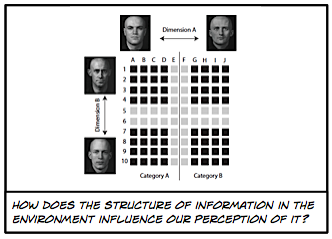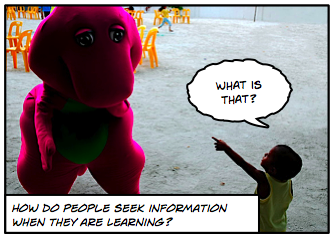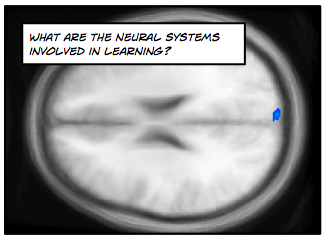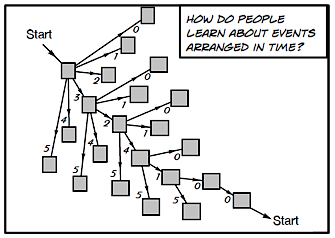|
|
|||
| research overview teaching nyuconcats resources/code github lab blog psiturk onmi *new* cogsci@nyu *new* |
publications by year by category |
people - everyone - |
location map |
|
The goal of our research is to better understand the memory, learning, and decision processes which allow humans to carry out intelligent and adaptive behaviors. The name of our lab is "computation and cognition" which reflects the two main strands that inform our work. Principally, we attempt to understand the nature of human cognition by developing computational theories of human information processing. By comparing the operation of formal models and the behavior of humans, we can gain insight into the mechanisms that people use to to solve problems and adapt their behavior. In addition, insights from these models can inform the development of artificial systems capable of learning on their own. We are particularly interested in how people learn from experience. Our research ranges from studies of the different neural systems that contribute to category and concept acquisition, to the interactions between categorization, memory, and perceptual processes, to (more recently) studies of how people learn by interacting with the world through exploration and information-search behaviors. To give you a better sense of some of the basic scientific questions we are interested in, we've highlighted below some of the main lines of work we are currently developing. Our lab paper archive has a full list of papers and abstracts. 
Our first, and in some sense primary, line of work deals with category and concept learning or how people learn to generalize from the instances they see in the world. For example, how do young children learn which plants belong to the category "tree" and which are "flowers"? Category learning is a critical cognitive ability which underlies a vast array of abilities such as object recognition and language acquisition. Our research in this area seeks a better understanding of the learning processes which support this ability and how they might be organized or implemented in the brain. Our work in this area combines a variety of methodologies including behavioral studies, neuro-imaging, and computational modeling. An example finding from our work:
Representative Publications: Markant, D. and Gureckis, T.M. (in review) "The impact of self-directed learning in a perceptual category learning task" Gureckis, T.M. and Goldstone, R.L.. (2008) "The effect of the internal structure of categories on perception" in Proceedings of the 30th Annual Conference of Cognitive Science Society Love, B.C., Medin, D.L., and Gureckis, T.M. (2004) SUSTAIN: A Network Model of Category Learning. Psychological Review, 11, 309-332. Gureckis, T.M. and Love, B.C. (2003). Towards a Unified Account of Supervised and Unsupervised Learning. Journal of Experimental and Theoretical Artifical Intelligence, 15, 1-24. 
A second line of work considers how learning can be viewed as an active (or interactive) process.
Imagine a young child just beginning to learn about how the world works. Some of the time, an adult is
nearby to provide feedback or instruction, but often times the child must learn on their own by trial
and error. In some of our recent work, we've looked at how people learn effective behavioral strategies
through interacting with dynamic task environments where reward structure continually changes in response
to the actions of the individual. In contrast to approaches that treat learners as passive
Representative Publications: Markant, D. and Gureckis, T.M. (2010) "Category Learning Through Active Sampling." in Proceedings of the 32nd Annual Conference of the Cognitive Science Society Gureckis, T.M. and Markant, D. (2009) "Modeling Information Search in a Spatial Concept Learning Game." in Proceedings of the 31st Annual Conference of the Cognitive Science Society Gureckis, T.M. and Love, B.C. (2009) Learning in Noise: Dynamic Decision-Making in an Uncertain Environment. Journal of Mathematical Psychology Gureckis, T.M. and Love, B.C. (2009) Short Term Gains, Long Term Pains: Reinforcement Learning in Dynamic Environments. Cognition 
Representative Publications: Gureckis, T.M., James, T.H., and Nosofsky, R.M. (2011). Reevaluting the dissociation between implicit and explicit category learning: A fMRI Study. Journal of Cognitive Neuroscience. Love, B.C. and Gureckis, T.M. (2007). Models in Search of the Brain. Cognitive and Affective Behavioral Neuroscience Gureckis, T.M. and Love, B.C. (2006). Bridging Levels: Using a Cognitive Model to Connect Brain and Behavior in Category Learning Proceedings of the 28th Annual Conference of Cognitive Science Society. Gureckis, T.M. and Love, B.C. (2004). Common Mechanisms in Infant and Adult Category Learning. Infancy, vol 5, no.2, 173-198. 
From the ability to move our hands
when we are typing to our ability to sequence actions of our mouths to make words,
a key aspect of human cognition is our ability to learn about event arranged in time.
However, what are the representational primitives that support such behavior? In this line of
work, we have examined how the statistical structure of the environment interacts with the
representations of the world we adopt to determine which things are easier or harder for people
to learn. Representative Publications: Gureckis, T.M. and Love, B.C. (2009) Learning in Noise: Dynamic Decision-Making in an Uncertain Environment. Journal of Mathematical Psychology Gureckis, T.M. and Love, B.C. (2009) Short Term Gains, Long Term Pains: Reinforcement Learning in Dynamic Environments. Cognition Gureckis, T.M. and Love, B.C. (2007) "Behaviorism Reborn? Statistical Learning as Simple Conditioning" in Proceedings of the 29th Annual Meeting of the Cognitive Science Society. Gureckis, T.M. and Love, B.C. (2005). A Critical Look at the Mechanisms Underlying Implicit Sequence Learning. Proceedings of the 27th Annual Conference of Cognitive Science Society. |
|||
|
Our work is supported by grants from  Copyright 2008-2013 - Todd Gureckis - New York University |
|||
 In one recent study, we looked at the influence that categories have on our perceptual abilities (Gureckis & Goldstone, 2008, in prep).
In this study we asked people to discriminate between a set of highly similar human faces. Then we taught them to assign
different subsets of the faces into categories. After learning, we again tested participant's discrimination ability.
The key finding is that, after learning, participants were less able to discriminate items that were assigned to the same
category and were better able to discrimination faces from different categories (a effect known as categorical perception).
More interestingly, we also found that the distribution of exemplars within each category also had an influence on people's
perception. Items that belonged to the same "cluster" of items inside a category were harder to discriminate after
learning than items that belong two different clusters within the same category. Thus, distinctions that were not
directly relevant for success in the learning task ended up influencing people's perception. We are currently following up
these studies to better understand the interplay of language, learning, and perception.
In one recent study, we looked at the influence that categories have on our perceptual abilities (Gureckis & Goldstone, 2008, in prep).
In this study we asked people to discriminate between a set of highly similar human faces. Then we taught them to assign
different subsets of the faces into categories. After learning, we again tested participant's discrimination ability.
The key finding is that, after learning, participants were less able to discriminate items that were assigned to the same
category and were better able to discrimination faces from different categories (a effect known as categorical perception).
More interestingly, we also found that the distribution of exemplars within each category also had an influence on people's
perception. Items that belonged to the same "cluster" of items inside a category were harder to discriminate after
learning than items that belong two different clusters within the same category. Thus, distinctions that were not
directly relevant for success in the learning task ended up influencing people's perception. We are currently following up
these studies to better understand the interplay of language, learning, and perception.
 observers, our goal in this work is to
develop theories of learning that can account for the active way in which we search, sample, and
explore our environment. On the computational side, this work applies the framework of
reinforcement learning (Sutton & Barto, 1998) to understand higher-level cognitive behavior and decision making.
Reinforcement learning is an agent-based approach to learning through interaction with the environment in
pursuit of goal-directed behavior. Reinforcement
learning is also a promising theoretical approach to studying higher-level human learning since it emphasizes the role of a situated agent interacting with their environment. For example, RL models specify how learners should balance exploration
versus exploitation of resources in their environment, how they take into account delayed rewards while learning, and how
to assign credit to actions that later lead to successful outcomes.
observers, our goal in this work is to
develop theories of learning that can account for the active way in which we search, sample, and
explore our environment. On the computational side, this work applies the framework of
reinforcement learning (Sutton & Barto, 1998) to understand higher-level cognitive behavior and decision making.
Reinforcement learning is an agent-based approach to learning through interaction with the environment in
pursuit of goal-directed behavior. Reinforcement
learning is also a promising theoretical approach to studying higher-level human learning since it emphasizes the role of a situated agent interacting with their environment. For example, RL models specify how learners should balance exploration
versus exploitation of resources in their environment, how they take into account delayed rewards while learning, and how
to assign credit to actions that later lead to successful outcomes.

